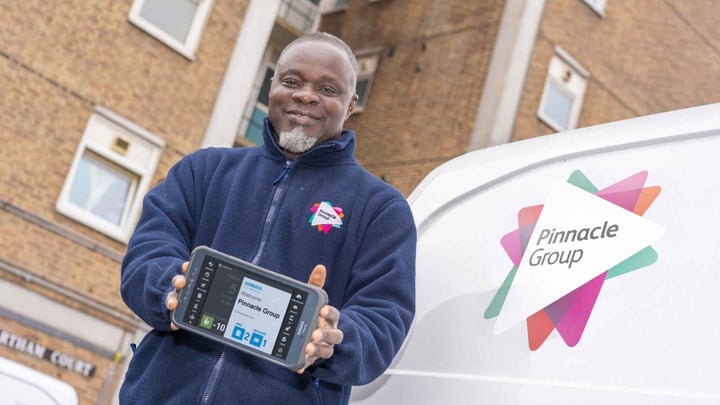Want to know more? The full white paper relating to this white paper is available as premium content to fieldservicenews.com subscribers...
sponsored by:


Data usage note: By accessing this content you consent to the contact details submitted when you registered as a subscriber to fieldservicenews.com to be shared with the listed sponsor of this premium content who may contact you for legitimate business reasons to discuss the content of this content.
Protect Your Most Valuable Assets – Your Staff
When it comes to field service, there is one maxim that rings truer than any other – it is people that drive your success. With this in mind, it is, of course, vital to protect the most valuable of all our assets – our staff.
The field service worker is inherently vulnerable.
Field service engineers can be found in all manner of hazardous environments – whether it be up pylons or deep underground. Working in isolated locations, with heavy machinery or surrounded by explosive materials – the field service engineer can be found tirelessly keeping the world moving.
And more often than not, they are working alone while doing it.
"A focus on Health and Safety doesn’t always have to be about risk avoidance and aversion..."
For this reason, it is little wonder that staff-safety is one of the most prevalent arguments put forward for investment in an FSM system – sometimes even ahead of the ROI discussion - which, as we have just seen, is also particularly robust.
Often, the scenario is that heavy industry regulation and legislation will drive the case forwards with certain industries such as healthcare, insurance or power generation being prime examples of this. However, it is equally common that an organisation will, of their own volition, ensure that they have made every effort to meet their moral obligation to put their worker’s safety at the forefront of their working priorities.
The interesting thing is that often by doing so they will once again see instant ROI through reduced insurance premiums that reflect the reduction of risk – and this is on top of all of the other potential savings we mentioned in the first section of this paper.
However, while these obvious benefits are easily identified, a focus on Health and Safety doesn’t always have to be about risk avoidance and aversion. A safety-first approach can yield significant other business benefits as proved by Alcoa’s former CEO Paul O,Neill - who increased profits five-fold when adopting such a position when he took on the CEO role.
Making Health And Safety A ‘Keystone Habit’:
“I want to talk to you about worker safety.”
These were Paul O’Neill’s words in his first speech as CEO of Alcoa. The room was full of nervous investors as Alcoa’s stock had been volatile after a series of failed products. It was a room expecting to hear promises of improved margins and bottom lines. Wall St was eager to hear of anticipated revenue projections and potential industry innovation.
But O’Neill was resolute in his focus, and that focus was Health and Safety.
“Every year, numerous Alcoa workers are injured so badly that they miss a day of work,” O’Neill continued. “Our safety record is better than the general American workforce, especially considering that our employees work with metals that are 1500 degrees and machines that can rip a man’s arm off. But it’s not good enough. I intend to make Alcoa the safest company in America. I intend to go for zero injuries.”
The room fell silent.
Across the following thirteen years that O’Neill remained at the helm of Alcoa, profits increased by 500%.
It is a case study highlighted in Charles Duhigg’s excellent book the ‘Power of Habit’ in which O’Neill discusses exactly how his focus on Health and Safety had such a profound impact - across O’Neill’s tenure, Alcoa dropped from 1.86 lost work days to injury per 100 workers to 0.2. By 2012, the rate had fallen to 0.125.
But the interesting thing is that that impact extended beyond worker health with the company’s profits hitting a record high just one year after O’Neill’s speech.
As O’Neill commented himself in an interview with Duhigg: “I knew I had to transform Alcoa. But you can’t order people to change.
“So, I decided I was going to start by focusing on one thing. If I could start disrupting the habits around one thing, it would spread throughout the entire company.”
Focusing on that one critical metric, what Duhigg refers to as a “keystone habit,” created a change that rippled through the entire business and changed the culture within Alcoa. This focus on worker safety lead to closer examinations of inefficient processes
How An FSM Solution Can Reduce The Risk For Your Field Service Engineers
It is evident then that not only is Health and Safety a significant driver for investment in FSM solutions, it can also yield many additional benefits ranging from the more self-evident risk reduction through to the less tangible, but equally impactful, aspects such as refinement of processes and establishment of company-wide best-practice.
So, let’s take a moment to explore some of the practical ways in which an FSM solution can provide additional safety for our field workers:
Lone Worker Protection:
Perhaps the absolute most dangerous aspect of field service work lies in the simple fact that the field service worker is very often working alone. Often the thin line between an accident and a tragic loss of life is simply the speed in which help arrives and when a field service worker has no colleague to alert the rescue services of an accident, technology is required to fill the gap.
Indeed, lone worker technology is a thriving sector within its own right, with various technologies including wearables that track vital health indicators such as heart rate, temperature and perspiration able to communicate to HQ should an engineers’ health suddenly deteriorate.
"A simple automated call to the engineer, if their app isn’t showing the correct activity within a specific timeframe, can help identify quickly when an engineer could potentially be in danger as a result of an accident..."
However, there are also many lone worker aspects already embedded within many FSM solutions. These are often simple yet highly effective tools that utilise the field engineer’s mobile phone or tablet’s GPS signal and whichever FSM application the engineer is already using to receive their work orders.
Something as simple as an automated call to the engineer, if their app isn’t showing the correct activity within a specific timeframe, can help identify quickly when an engineer could potentially be in danger as a result of an accident.
Similarly, simple geo-fencing could identify when an engineer has had to travel to a particularly remote area and ensure that the engineer ‘checks in’ at specified intervals.
Vehicle Management:
Field service engineers spend more time in their vehicle than anywhere else, so it makes huge sense for vehicle maintenance to be a significant part of the wider field service management health and safety considerations.
As with lone worker protection, many dedicated fleet management solutions incorporate vehicle maintenance solutions, often using detailed telemetric data to keep track of the health of the vehicle. However, a simple visual inspection at the beginning and end of a shift can have a major impact on reducing regular wear and tear of vehicles, once again not only minimising any risk a field service engineer is exposed to, but also reducing costs via lowered insurance premiums and preventive rather than reactive maintenance of fleet vehicles.
"By embedding such tasks directly into the engineers’ workflow, an organisation can achieve maximum participation and by collating the data and then connecting it to the wider scheduling system.."
Such a visual inspection can be promoted within a standard FSM solution by utilising a dedicated checklist that must be completed before an engineer can access his jobs at the start of the day or log his final job completion at the end of the day.
By embedding such tasks directly into the engineers’ workflow, an organisation can achieve maximum participation and by collating the data and then connecting it to the wider scheduling system. Any non-urgent vehicle maintenance can be automatically allocated to occur when the engineer is on scheduled leave.
On-site checklists:
Using the same approach as outlined above, we can also guarantee that the correct procedures are followed every time an engineer completes a maintenance task.
Often, it is not a lack of experience that puts an engineer at risk; it is simply the natural human tendency of complacency.
All too often we hear stories of the experienced field service engineer who was just that little bit rushed, or whose mind was just that little bit distracted, that they forgot to turn off the mains power before beginning a repair.
These are stories that sadly, tend to not end well.
Once again, by embedding a checklist within the engineer’s workflow, one that must be completed to allow the engineer to progress with the job he is working on, such issues can be significantly reduced if not overcome altogether.
Want to know more? The full white paper relating to this white paper is available as premium content to fieldservicenews.com subscribers...
sponsored by:


Data usage note: By accessing this content you consent to the contact details submitted when you registered as a subscriber to fieldservicenews.com to be shared with the listed sponsor of this premium content who may contact you for legitimate business reasons to discuss the content of this content.
Published in partnership with HSO find out more about how they can help your field service operation @ www.hso.com























 Field Service News is published by 1927 Media Ltd, an independent publisher whose sole focus is on the field service sector. As such our entire resources are focused on helping drive the field service sector forwards and aiming to best serve our industry through honest, incisive and innovative media coverage of the global field service sector.
Field Service News is published by 1927 Media Ltd, an independent publisher whose sole focus is on the field service sector. As such our entire resources are focused on helping drive the field service sector forwards and aiming to best serve our industry through honest, incisive and innovative media coverage of the global field service sector.
Leave a Reply